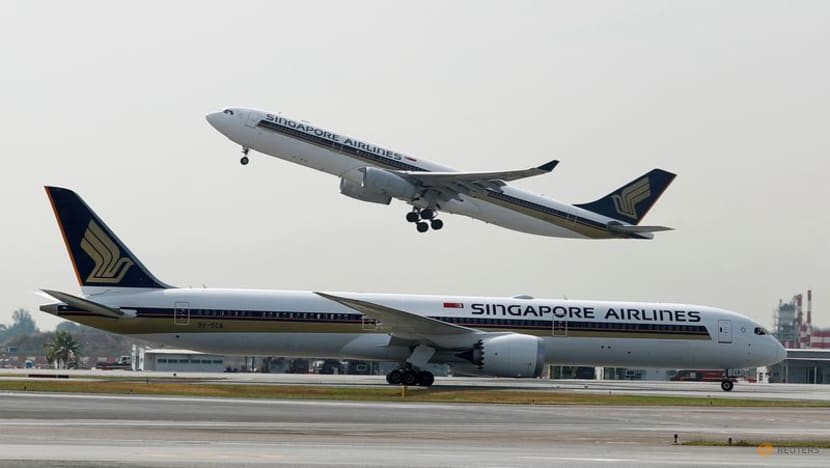SIA delivers strong Q3 results but analysts warn of challenges like rising competition, high fuel prices
This could mean “limited” upside to SIA’s share prices, analysts said.

A Singapore Airlines Airbus A330-300 plane takes off behind a Boeing 787-10 Dreamliner at Changi Airport in Singapore, on Mar 28, 2018. (Photo: REUTERS/Edgar Su)
SINGAPORE: The post-pandemic recovery for Singapore Airlines (SIA) continues with the airline turning in another strong quarterly report card, but analysts caution that challenges loom ahead in the form of rising competition, slowing economic growth and high fuel prices.
The national carrier on Tuesday (Feb 21) said its net profit for the third quarter ending Dec 31 came in at S$628 million, up 12.7 per cent from the previous quarter. Total revenue gained 8 per cent over the same period to S$4.85 billion.
This earnings surge came on the back of a continued strong recovery in air travel demand.
SIA said passenger capacity for the group reached 80 per cent of pre-pandemic levels in December 2022. When combined, SIA and Scoot carried 7.4 million passengers for the whole of third quarter, 17 per cent more than the previous three months.
Passenger load factors, which measure how well airlines are filling available seats, gained 0.8 percentage points to 87.4 per cent – the highest for any quarter – on the back of record load factors for both SIA and Scoot.
But competition is rising on this front, as other airlines race to resume more flights.
“Many Asian airlines – for example, Cathay Pacific, AirAsia, and the Chinese airlines – are looking to regain lost routes and capacities, which would mean increased competition and a decline in international passenger fares,” said Mr Shekhar Jaiswal, head of equity research at RHB Singapore.
The latter, he added, will put pressure on passenger yields or the average price paid by a passenger for each kilometre.
Related:
Another risk threatening to derail the recovery in passenger traffic is the state of the global economy.
Elevated interest rates for a longer period of time would increase the possibility of slower global growth – or worse, a recession – which will in turn hurt travel demand, said Mr Jaiswal.
The dark cloud over global growth also poses a threat for SIA’s cargo business, which is already seeing signs of a slowdown.
The airline, in its earnings report, said performance for its cargo segment moderated in the third quarter due to softening demand and an increase in bellyhold capacity. Yields were weaker on a quarter-on-quarter basis, although they remained elevated compared to pre-pandemic levels.
CGS-CIMB analyst Raymond Yap said the cargo business will “weaken at a faster rate” going forward.
This is due to factors such as a slowdown in demand for consumer goods amid rising inflation and the decongestion in shipping routes that has seen container freight rates falling back to pre-pandemic levels, he added.
Then, there is the risk of higher oil prices.
SIA has only hedged 40 per cent of its fuel requirements at an average Brent strike price of US$60 per barrel up to June this year, said Mr Yap, adding that the expiry of these fuel hedges is a downside risk.
Echoing a similar sentiment, Mr James Ooi, a market strategist at uSMART Securities, said: “Crude oil may surpass US$100 later this year, which could add further pressure on the airline’s expenditure.”
Describing SIA’s quarterly net profit as having “likely (passed) the peak”, Mr Yap expects the airline’s fourth-quarter net profit to dip to S$586 million.
“Still very robust, albeit below the near all-time peak of S$628 million in the third quarter,” he wrote in a note.
Mr Ooi is more optimistic and expects another record quarterly profit for SIA in the fourth quarter.
The prospects of further recovery in air travel “remain promising” for now, he said, citing the reopening of China and increasing international visitor arrivals into Singapore.
Latest figures showed the country welcoming 931,530 international travellers in January – a new record since the onset of the COVID-19 pandemic.
Still, that is way below the 1.5 million average in visitor numbers of 2019, indicating further room for growth, said Mr Ooi.
WHAT THAT MEANS FOR SIA’S SHARES
The strong results did not appear to be much of a boost for the airline’s stock, which dropped 0.17 per cent, or S$0.01, to finish at S$5.77 on Wednesday.
Analysts said this can be attributed to downbeat sentiment in the broader Singapore market, following overnight losses in the US and Europe markets. The Straits Times Index (STI) fell 0.21 per cent for the day.
Another reason is that the earnings report, while promising, did not come as “too big of a surprise” amid the world’s gradual return to normalcy, said IG market strategist Yeap Jun Rong.
On top of that, SIA’s share prices have risen more than 20 per cent from its trough in October, with the bulk of the surge happening last month on the back of China’s reopening news. This means that much of the recovery-related exuberance has already been priced in by the market, he added.
“The challenge now will be if they can continue to keep up with the growth momentum,” Mr Yeap said. “How long the pent-up travel demand can sustain and whether we have already seen the bulk of its catch-up recovery, will be something on investors’ mind.”
RHB’s Mr Jaiswal is expecting “limited” upside to SIA’s share price given the risk of increased competition and lower demand for both passenger and cargo amid recession fears.
Mr Ooi has a year-end target of S$6.26 for the stock, while Mr Yap has raised his target price to S$6.14.
Meanwhile, SIA could declare a final dividend of 27 Singapore cents per share when it releases its next quarterly results, according to CGS-CIMB.
The carrier had, as part of its second-quarter results, declared an interim dividend of 10 Singapore cents per share – its first in three years.

















